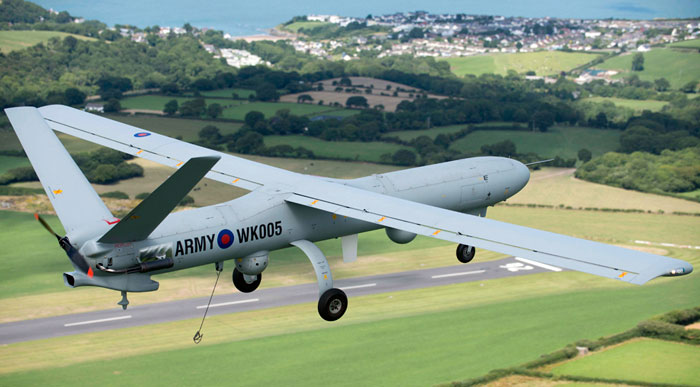The British Army is expected to induct the long awaited Watchkeeper UAV system with its field units, following Release To Service (RTS) by the UK’s Ministry of Defence (MOD). Unfortunately, this milestone is achieved three years behind schedule.

Certified to the same safety standard as manned aircraft, Watchkeeper is the first UAS to be awarded a full (RTS) and is the only UAS of its type allowed to fly in UK airspace. Although 26 air vehicles and 14 ground systems already produced, lack of the formal safety clearance prevented the full induction of the drone with Army units. Thales UK is on contract to deliver 28 additional systems and one additional ground system.
Cleared for operations in the UK, the RTS will allow army crews to fly Watchkeeper sorties in segregated airspace, integrating with the military exercises taking place on Salisbury Plain. The RTS follows the announcement (24 February) that the British Army will begin training flights from Boscombe Down, Wiltshire. Sofar the drone operations were restricted to testing and evaluation – nearly 1000 flight hours were performed by the operators of the prime contractor, Thales UK, 600 of these flights were performed in the approved test airspace near Parc Aberporth, West Wales.

Lt Col Craig Palmer of the British Army commended the high safety levels demonstrated by the new system, “The safety bar for Watchkeeper has been set very high. The detailed reviews and testing of the whole system have provided significant evidence that the system is maturing rapidly; sufficiently enough to support an RTS recommendation.” Over the coming weeks the pilots and support crews of 1st Artillery Brigade will be trained to fly the drones in a restricted airspace over the Salisbury Plain Training Area. The flights, which will take place between 8,000 and 16,000 feet, will be overseen by military air traffic controllers.
“The process of achieving RTS and the other certifications required for Watchkeeper has been ground-breaking, not only for Thales but also for the MOD and the CAA”, said Victor Chavez, CEO of Thales UK. “Much painstaking work has been required by all parties to deliver the comprehensive and rigorous certification, but our collective achievement is a great one: the first tactical UAS allowed to fly in UK airspace.”
An RTS is the formal statement, on behalf of the Chief of General Staff, that an acceptable safety case has been prepared for the aircraft and its equipment. An RTS is required for all aircraft (manned and unmanned) subject to Military Aviation Authority (MAA) regulated service flying, and is written for the aircrew and engineers responsible for the day-to-day supervision of flying operations and the desk officers responsible for developing policy and procedures.
Watchkeeper is a high-performance, multi-sensor, all-weather UAS that can remain airborne for more than 16 hours in a single mission. These unarmed tactical UAS will be deployed by the British Army surveillance, reconnaissance, intelligence gathering and target acquisition missions, in support of military operations at supporting brigade-level and below. Watchkeeper is expected to remain in service at least until 2040.
Watchkeeper has been developed by Thales with strong support from its supply chain, including UAV Tactical Systems Limited (U-TacS), which was established at contract award as a joint venture company between Thales and Elbit Systems.

















